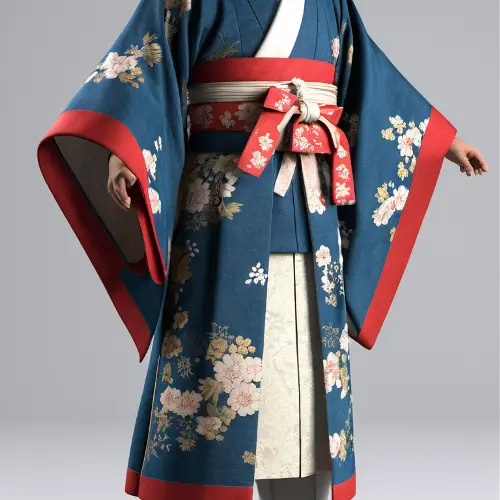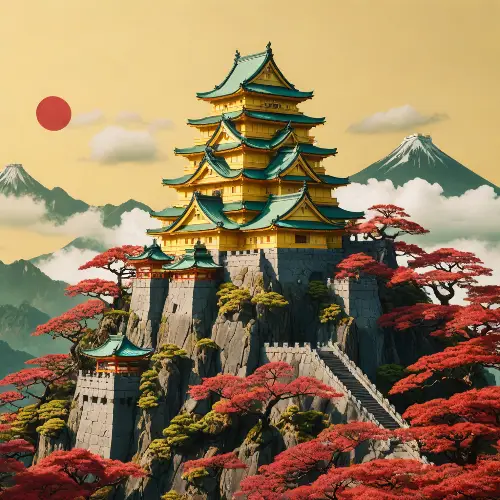In a forward-facing continuous horizontal sequence, from left to right, focus on Taipeis Xinyi District in Taiwan, showcasing the changing landscapes over different historical periods: 1. Qing Dynasty: - In the leftmost section, depict Taipeis Xinyi District during the Qing Dynasty, emphasizing natural landscapes and rural features such as fields and water buffaloes. - Highlight the architectural style of the Qing Dynasty, creating an atmosphere of ancient tranquility with features like traditional courtyard houses, rural structures, and temples. 2. Japanese Colonial Period: - In the left-central section, present the Xinyi District during the Japanese colonial era, emphasizing potential Japanese architectural styles and street scenes, such as the Matsuyama Tobacco Factory, granaries, and Baroque-style buildings. - Highlight the modernization brought during the Japanese colonial period, including changes in transportation, architecture, and culture, for instance, the introduction of railways. 3. Early Taiwanese Republic: - In the right-central section, describe the Xinyi District during the early years of the Taiwanese Republic, particularly in the 1920s to 1940s, featuring elements like military dependents villages. - Emphasize the revival of Taiwanese indigenous culture and the evolution of architectural styles, showcasing a unique social landscape with a blend of traditional and modern influences. 4. Modern Landmarks: - In the rightmost section, showcase the modern urban landscape of contemporary Xinyi District, featuring skyscrapers, commercial areas, and modern architecture, including landmarks like Taipei 101. - Highlight contemporary cultural features such as art, shopping districts, and entertainment venues, such as the Da Dao Cheng Plaza.
In a forward-facing continuous horizontal sequence, from left to right, focus on Taipeis Xinyi District in Taiwan, showcasing the changing landscapes over different historical periods: 1. Qing Dynasty: - In the leftmost section, depict Taipeis Xinyi District during the Qing Dynasty, emphasizing natural landscapes and rural features such as fields and water buffaloes. - Highlight the architectural style of the Qing Dynasty, creating an atmosphere of ancient tranquility with features like traditional courtyard houses, rural structures, and temples. 2. Japanese Colonial Period: - In the left-central section, present the Xinyi District during the Japanese colonial era, emphasizing potential Japanese architectural styles and street scenes, such as the Matsuyama Tobacco Factory, granaries, and Baroque-style buildings. - Highlight the modernization brought during the Japanese colonial period, including changes in transportation, architecture, and culture, for instance, the introduction of railways. 3. Early Taiwanese Republic: - In the right-central section, describe the Xinyi District during the early years of the Taiwanese Republic, particularly in the 1920s to 1940s, featuring elements like military dependents villages. - Emphasize the revival of Taiwanese indigenous culture and the evolution of architectural styles, showcasing a unique social landscape with a blend of traditional and modern influences. 4. Modern Landmarks: - In the rightmost section, showcase the modern urban landscape of contemporary Xinyi District, featuring skyscrapers, commercial areas, and modern architecture, including landmarks like Taipei 101. - Highlight contemporary cultural features such as art, shopping districts, and entertainment venues, such as the Da Dao Cheng Plaza.
In a forward-facing continuous horizontal sequence, from left to right, focus on Taipeis Xinyi District in Taiwan, showcasing the changing landscapes over different historical periods: 1. Qing Dynasty: - In the leftmost section, depict Taipeis Xinyi District during the Qing Dynasty, emphasizing natural landscapes and rural features such as fields and water buffaloes. - Highlight the architectural style of the Qing Dynasty, creating an atmosphere of ancient tranquility with features like traditional courtyard houses, rural structures, and temples. 2. Japanese Colonial Period: - In the left-central section, present the Xinyi District during the Japanese colonial era, emphasizing potential Japanese architectural styles and street scenes, such as the Matsuyama Tobacco Factory, granaries, and Baroque-style buildings. - Highlight the modernization brought during the Japanese colonial period, including changes in transportation, architecture, and culture, for instance, the introduction of railways. 3. Early Taiwanese Republic: - In the right-central section, describe the Xinyi District during the early years of the Taiwanese Republic, particularly in the 1920s to 1940s, featuring elements like military dependents villages. - Emphasize the revival of Taiwanese indigenous culture and the evolution of architectural styles, showcasing a unique social landscape with a blend of traditional and modern influences. 4. Modern Landmarks: - In the rightmost section, showcase the modern urban landscape of contemporary Xinyi District, featuring skyscrapers, commercial areas, and modern architecture, including landmarks like Taipei 101. - Highlight contemporary cultural features such as art, shopping districts, and entertainment venues, such as the Da Dao Cheng Plaza.
In a forward-facing continuous horizontal sequence, from left to right, focus on Taipeis Xinyi District in Taiwan, showcasing the changing landscapes over different historical periods: 1. Qing Dynasty: - In the leftmost section, depict Taipeis Xinyi District during the Qing Dynasty, emphasizing natural landscapes and rural features such as fields and water buffaloes. - Highlight the architectural style of the Qing Dynasty, creating an atmosphere of ancient tranquility with features like traditional courtyard houses, rural structures, and temples. 2. Japanese Colonial Period: - In the left-central section, present the Xinyi District during the Japanese colonial era, emphasizing potential Japanese architectural styles and street scenes, such as the Matsuyama Tobacco Factory, granaries, and Baroque-style buildings. - Highlight the modernization brought during the Japanese colonial period, including changes in transportation, architecture, and culture, for instance, the introduction of railways. 3. Early Taiwanese Republic: - In the right-central section, describe the Xinyi District during the early years of the Taiwanese Republic, particularly in the 1920s to 1940s, featuring elements like military dependents villages. - Emphasize the revival of Taiwanese indigenous culture and the evolution of architectural styles, showcasing a unique social landscape with a blend of traditional and modern influences. 4. Modern Landmarks: - In the rightmost section, showcase the modern urban landscape of contemporary Xinyi District, featuring skyscrapers, commercial areas, and modern architecture, including landmarks like Taipei 101. - Highlight contemporary cultural features such as art, shopping districts, and entertainment venues, such as the Da Dao Cheng Plaza.
In a forward-view continuous horizontal sequence, focus on Taipeis Xinyi District in Taiwan, depicting the evolving landscape across different time periods in four segments: 1. Qing Dynasty Period: - Illustrate Taipeis Xinyi District during the Qing Dynasty, emphasizing the natural scenery and rural features of that era, such as fields, water buffaloes. - Highlight the architectural style of the Qing Dynasty, creating an atmosphere rich in ancient and tranquil elements, including features like traditional courtyards, rural outskirts, and temples. 2. Japanese Colonial Period: - Present the Xinyi District during the Japanese colonial era, emphasizing potential Japanese-style architecture and street scenes, such as the Matsuyama Tobacco Factory, granaries, and Baroque-style buildings. - Spotlight the modernization brought about during the Japanese colonial period, showcasing changes in transportation, architecture, and culture, including the introduction of railways. 3. Early Taiwanese Republic: - Describe the Xinyi District during the early years of the Taiwanese Republic, especially in the 1920s to 1940s, featuring aspects like military dependents villages. - Emphasize the revival of indigenous Taiwanese culture during this time and the evolution of architectural styles, showcasing unique social characteristics such as a blend of classical or Sino-Western architectural styles. 4. Modern Landmarks: - Showcase the modern urban landscape of Xinyi District, including skyscrapers, commercial areas, and contemporary architecture like the iconic Taipei 101. - Highlight contemporary cultural features such as art, shopping districts, and entertainment venues, such as the Da Dao Cheng Plaza. Ensure clear and cohesive transitions between each period, allowing StableDreamer to smoothly create a visually connected timeline. Thank you!
In a forward-view continuous horizontal sequence, focus on Taipeis Xinyi District in Taiwan, depicting the evolving landscape across different time periods in four segments: 1. Qing Dynasty Period: - Illustrate Taipeis Xinyi District during the Qing Dynasty, emphasizing the natural scenery and rural features of that era, such as fields, water buffaloes. - Highlight the architectural style of the Qing Dynasty, creating an atmosphere rich in ancient and tranquil elements, including features like traditional courtyards, rural outskirts, and temples. 2. Japanese Colonial Period: - Present the Xinyi District during the Japanese colonial era, emphasizing potential Japanese-style architecture and street scenes, such as the Matsuyama Tobacco Factory, granaries, and Baroque-style buildings. - Spotlight the modernization brought about during the Japanese colonial period, showcasing changes in transportation, architecture, and culture, including the introduction of railways. 3. Early Taiwanese Republic: - Describe the Xinyi District during the early years of the Taiwanese Republic, especially in the 1920s to 1940s, featuring aspects like military dependents villages. - Emphasize the revival of indigenous Taiwanese culture during this time and the evolution of architectural styles, showcasing unique social characteristics such as a blend of classical or Sino-Western architectural styles. 4. Modern Landmarks: - Showcase the modern urban landscape of Xinyi District, including skyscrapers, commercial areas, and contemporary architecture like the iconic Taipei 101. - Highlight contemporary cultural features such as art, shopping districts, and entertainment venues, such as the Da Dao Cheng Plaza.
Here are the instructions for capturing the scenes in Taipeis Xinyi District using a continuous perspective from the front angle, divided into four segments, each highlighting different historical periods: Qing Dynasty Period: Journey through the Qing Dynasty period, showcasing the original appearance of Xinyi District with pastoral landscapes and traditional architecture. Highlight the cultural features and natural scenery of the Qing Dynasty era. Japanese Colonial Period: Transition to the Japanese colonial era, capturing the street scenes and architectural styles of that time. Highlight the architectural traces and street appearances during the Japanese rule, including the commercial and residential areas. Early Taiwan Republic Period: Move to the early days of the Taiwan Republic, presenting scenes of transition reflecting the societal changes. Emphasize the architectural features, social activities, and emerging urban development of the early Taiwan Republic period. Modern Landmarks and Characteristics: Switch to the modern era, showcasing the contemporary appearance of Xinyi District. Highlight skyscrapers, commercial districts, modern art venues, and the distinctive features of contemporary urban life.
Create a visual representation from a forward perspective, using Taipei's Xinyi District in Taiwan as the backdrop. Divide the scene into four segments, showcasing the changing landscapes across different historical periods. Include the Qing Dynasty era, Japanese colonial period, early days of Taiwan's independence, and modern iconic features. 1. Qing Dynasty: - Emphasize traditional aspects with old streets and architecture, depicting the cultural and religious elements of the Qing era. 2. Japanese Colonial Period: - Illustrate the architectural styles of the Japanese rule, potentially featuring government structures, schools, and commercial areas, highlighting the influence of Japanese culture. 3. Early Days of Taiwan's Independence: - Capture the transitional period with political buildings, markets, and residences, showcasing the unique features and societal changes during this time. 4. Modern Iconic Features: - Include contemporary skyscrapers, business districts, shopping centers, and other modern structures. Highlight the prosperity and urban sophistication of modern-day Xinyi District, Taipei.
Japanese-style houses, business district, mountains, scenes, fields, realistic
Japanese-style houses, business district, ordinary mountains, scenes, fields, realistic, retro
Japanese-style architecture, commercial district, scene, field, realistic, early period
Scene, Qing Dynasty, field, architecture, early Republic of China, architecture, mountain, Japanese style, modern architecture, street view, overhead view, merged into one, scene changes in Xinyi District, Taiwan
Japanese-style houses, commercial district, scene, fields, realistic, retro
Japanese-style architecture, commercial district, scene, field, realistic
Japanese-style architecture, commercial district, scene, field, realistic
Japanese-style architecture, business district, scene, field, realistic, retro
Japanese-style architecture, business district, scene, field, realistic, retro
Capture an image of a stone mountain temple on the island of Azural. The temple's entrance is carved into the rock, adorned with intricately tied ropes in a Japanese style, reminiscent of sacred Shinto gates. The grandeur of the stone structure stands against the backdrop of the lush landscape, blending nature's serenity with the aura of divine reverence
front scene of a jade japan style castle in a mountain , a yellow sky , some cicular clouds, small trees with red leafs in the left, in the background need to have an other mountain with some moss
front scene of a jade japan style castle in a mountain , a yellow sky , some cicular clouds, small trees with red leafs in the left, in the background need to have an other mountain with some moss
front scene of a jade japan style castle in a mountain , a yellow sky , some cicular clouds, small trees with red leafs in the left, in the background need to have an other mountain with some moss
scene of a jade japan style castle in a mountain with stairs in front of the castle, the sky is golden with some cicular form clouds, in the left needs to be some small trees with red leafs and in the background need to have an other mountain with some moss







































































